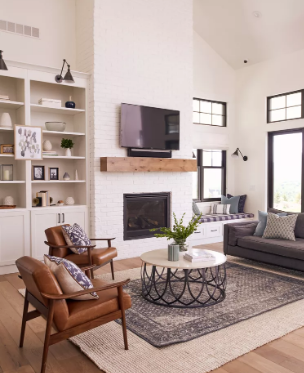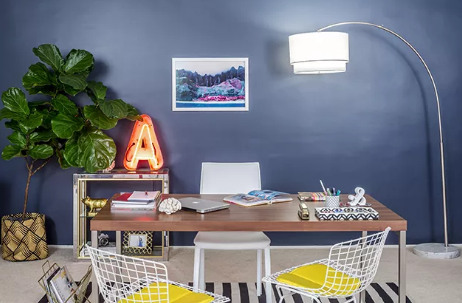
Bathroom Rugs: Pros and Cons
February 16, 2024
How to Clean a Jute Carpet in 4 Steps
February 21, 2024Choosing the perfect area rug for your space is hard enough. But stacking rugs can feel completely impossible, as you have to think about the perfect combination of colors, sizes, and textures. To give your space a new look or take advantage of the extra rugs you’ve stored, consider layering rugs with the help of some design experts. They share how to do this properly, including getting the right proportions and what mistakes to avoid, as well as some safety tips you may not have considered.

“Layering is a personal decision, there are no real rules,” says Rickie Broff, head of sales at Fayette Studio, who specializes in custom rug design. “In order to achieve a cohesive and balanced look, it is very important to be thoughtful and intentionally layered,” she said. “If done correctly, it could be a great design choice.”
Use the following guidelines and expert advice to stack rugs comfortably and use your creativity to create your own final look.
Why You Should Try Layered Rugs
If you haven’t tried stacking rugs before, there are many reasons why you should consider this trend. First of all, “it’s practical when trying to fix separate spaces in a large room,” says Buroff. For example, in an open-concept living room, she suggests adding an area rug to an existing rug to create an area such as a reading corner or under a card table. “Layered rugs add depth, texture and visual interest to a room and create a cozy atmosphere,” she says.

Kate Lester, creative director and CEO of Kate Lester Interiors, explains that there is more than one benefit to the carpet layering trend. Let’s say you want a high-end rug, but the price of the right size for your space is out of your budget. Or, you want to experiment with bold colors but aren’t ready to put them into practice. “Carpet layering allows you to incorporate something retro or colorful on a small scale,” Lester says, “and it’s beneficial for people who can’t invest in something substantial because they can pair a smaller version with a larger, more accessible version.” Or a soft carpet.”
Lester explains that placing a small colorful rug on a larger, neutral rug may be the secret to making the rug work in an otherwise unusable space. “Have fun when layering,” she said. “Pick up that stunning vintage Turkish piece that might be a little too small and let it sparkle on a fantastic woven piece.”
Another double advantage of layering is that it can mask the wear and tear on a much-loved rug, or allow you to use a rug that would otherwise look shabby. “If your favorite rug is too small or worn, placing it on top of or below another rug can create an illustration without looking disproportionate or noticing a flaw,” says Brov.”
How to Layer a Rug: Designers Share Their Best Tips
1. Always Start with the Basics

If there’s one rule to follow when trying a multi-layered rug look, it’s this one. Chelsey Brown, author of Closing the Front Door and founder of City Chic Decor, explains why this is an important first step. “Start by choosing a rug as a base, which is large enough to fit underneath most of the furniture in the space,” she says. In other words, the pedestal rug should be easy to place on the front legs of the sofa, on the side chairs, and on the coffee table in the living room. She explains that the underfloor carpet essentially acts as a canvas for the rest of the layered look. You can experiment with how to arrange everything else on top of it, but you don’t want the base to move.
Brown also recommends deciding on a style or theme at the beginning. “You can choose contrasting or complementary colors and patterns,” she says. “For example, a rug with a neutral undertone can be a perfect match with a colored or patterned rug on top. Or even something deformed – my favorite.”
2. Position the Carpet Correctly
The next step is something that Brown is also strongly focused on, as she believes is key to creating a cohesive look. “When you stack carpets, you have to overlap them a little bit,” she said. “Place the smaller rug at an angle or in the center of the larger rug.”
She explains that the shape doesn’t have to be important, as you can layer or blend two layers of the same shape. “I personally use a rectangular rug as a base with a wavy rug on top and place it under the ottoman,” she said. Finally, she recommends experimenting with different shapes to find the one that works best for your space.
3. Multi-layer Carpets of Different Proportions
While this is not always the case, carpet layering typically involves one larger rug and one smaller rug. Brov confirms that two very different sizes are a factor that she always considers. It makes sense that the bottom rug needs to be bigger so you can really see both. But Brov adds, “The bottom carpet should be much larger than the top, so that one carpet can take up space and one carpet can serve as an accentuator.”

Another thing Lester recommends keeping in mind is that the bottom rug should always fit the size of the room. She agrees with Brown that all furniture legs should fit into the carpet as a bonus to make the small room appear larger.
4. Layer Carpets with Different Textures
Carpets naturally add texture to a room, so using multiple rugs is an opportunity to add texture and add more dimension to the space. Brown explains that layering carpets with different textures creates a cozy and welcoming atmosphere. She recommends stacking fluffy, long-wool rugs, such as shag rugs, on top of short plush or plain weave rugs, like many washable rugs. “This textural contrast not only goes beyond visual appeal, but it also adds depth to the space and can even serve as a feature statement for your room,” she says.
Brove says she usually likes to use rugs made from natural or organic materials, such as sisal or jute, as a base and put something more visually interesting, perhaps with a pattern, on top.

5. Stack Carpets of Different Colors or Patterns
By playing with patterns and colors during the layering process, you have the flexibility to incorporate your personal touch into the space. Remember, though, that less is more. Like Brown, Lester likes to stick to neutral undertones, which come from her Harman Natural collection with Jaipur Living, and add color, pattern, or texture to the top rug.
Brown warns that if you’re thinking about using patterns, make sure they don’t collide. “It’s usually best to balance things out with one rug with a complex pattern and another with a softer or solid color,” she says.

6. Avoid These Design Mistakes
It’s easy to overdo carpet layering, especially when you start combining colors, textures, and patterns. A common pitfall, Brov explains, is trying to do too many things at once. “Using a rug that conflicts with a conflicting pattern or color can create a confusing or confusing look and make a room look cluttered and awkward,” she says.
Lester noted that she doesn’t like to stack two colored rugs or rugs of the same material. “The juxtaposition of textures and colors makes layered rugs interesting,” she says.

7. Safety Tips to Follow When Stacking Rugs
“When laying carpets, it’s important to consider the location of the furniture and the flow of the room,” says Brov. “I pay attention to the location of the flow of people so that there is no tripping hazard. Never carpet on stairs or in small spaces. In addition to proper placement, Brov also recommends placing a carpet mat under the bottom carpet so that the carpet is fixed to the floor.
Brown also recommends the use of carpet mats and says she always uses them after an unfortunate personal event. “Once, I was chasing my dog in my apartment trying to snatch a sock from its mouth and ended up tripping over the carpet at the entrance,” she shared. Now, she always makes sure to fix the carpet. “Once you’re happy with the placement of the layered rug, use tape or mats to hold them in place to prevent the rug from slipping,” she advises.



